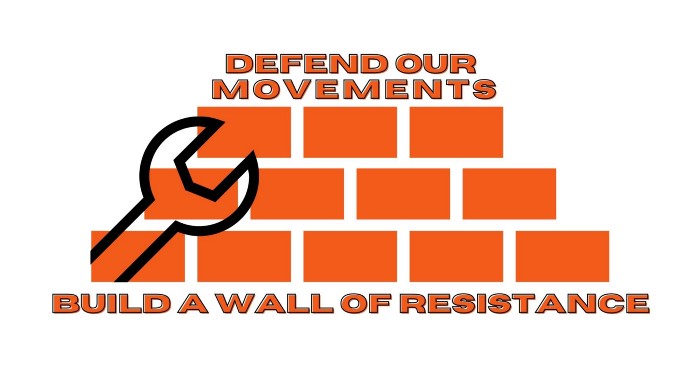
As someone who was an activist during the high tide of radical organizing in the 60s-70s, and witnessed the state’s unrelenting drive to destroy left movements, especially those led by Black, Indigenous and people of color, this week’s events sent chills down my spine. I witnessed the devastating effects of the surveillance and infiltration of the COINTELPRO program that led to the imprisonment of dozens of leaders. I saw powerful organizers murdered by law enforcement, like Fred Hampton, who was executed while he slept.
When the Department of Homeland Security’s Secretary Chad Wolf announced DHS’s intent to arrest leaders of Black Lives Matter I felt an eerie familiarity with J. Edgar Hoover’s designation of the Black Panthers as “the greatest threat to the security of the U.S.” Wolf’s September 1 announcement that the Justice Department is “targeting and investigating the head of these organizations, the individuals that are paying for these individuals to move across the country” came amid sustained protests over the shooting of Jacob Blake in Kenosha, Wisconsin.
Two days later, Federal agents shot and killed Michael Reinhoel, an anti-fascist activist suspected in the killing of a member of a white supremacist group during a recent protest in Portland.They executed Reinoehl hours after a warrant for his arrest was issued.
Trump has declared war on the left as his centerpiece for re-election, and advances that war daily. With protests taking place in more than 1,700 cities, the Movement for Black Lives and antifascist activists have consistently been targets in this period.
The state has always made concerted attempts to destroy resistance movements that challenge white supremacy, settler colonialism, war and patriarchy. What is happening isn’t new, but this regime is signaling intent to reach depths of repression this country hasn’t seen in over a century.
In July, the Trump administration sent Federal troops to Portland where cops were already using a highly militarized strategy with tear gas, pepper spray, and rubber bullets against demonstrators and he continues to threaten to send them to other cities. Hundreds of protesters have been arrested across the nation since the beginning of the Black-led uprising sweeping the country after the murders of George Floyd and Breonna Taylor. Many young people of color are facing years behind bars for things like kicking the door of a police car or hitting a cop with a water bottle.
People organizing in defense of Indigenous land and lives have also been heavily targeted in a resurgence of repression since Standing Rock. Nick Tilsen, President of the NDN Collective, was arrested along with 20 other land defenders protesting Trump’s photo op at Mt. Rushmore on July 4. Tilsen faces 17 years in prison for that action, part of the #LandBack movement demanding a return of the sacred Black Hills to Indigneous people.
Together, we need to ask: What can we learn from previous movements that will fortify us against the increased repression that we anticipate? How do we keep each other safe? And how can we organize ourselves so that resisting state repression is not just for defense but becomes a way to build stronger, smarter, and bigger movements?
Our safety has to be seen as collective, not just individual: “If they come for any of us, they have to go through all of us” should define our stance. Our ability to resist and defeat the state’s tactics depends on our ability to see ourselves as interconnected and interdependent – what happens to one part of our movement happens to all of us.

Here are some ways we can build a strong wall of resistance:
Know your rights in relationship to law enforcement and assert them. Nothing good comes from talking to the police or federal agents. You may not think anything you might say could be used against you or against others, but history warns us not to risk it.
You have a constitutional right to remain silent, and it’s best to to rely on that when approached by law enforcement and do not talk to police, even if you are detained. The only exceptions are these: you have to identify yourself if a) you’re stopped while driving a car and b) if you live in state with a “stop and identify” statute. Ask if you are being detained – you can say, “Am I free to go?” If the answer is yes, leave. If you are detained, ask to speak to a lawyer. If the FBI comes to your door, your best response is “I have nothing to say to you. I will have my lawyer contact you.” Never allow law enforcement to search your person or property without a valid warrant, specifying the objects to be searched for, dated, and signed by a judge. Call the National Lawyers Guild Anti-Repression Hotline at (212) 679-2811 to speak with an attorney at no cost if you are visited by the FBI.Resist grand juries. The grand juries going on now in several cities are essentially “fishing expeditions” to learn about movement connections and alliances, bring false charges, understand political positions, and make use of political differences to cause distrust and divide movements. There is a long history of grand jury resistance that we can learn from and uphold.
Support people who are targeted by the state. We have seen for decades the way the state brings political cases against BIPOC leaders and their allies to try to weaken our movements, and make people afraid to resist. Some political prisoners, like Jalil Muntaqim and Leonard Peltier, still remain inside after 40 or 50 years of incarceration.
Defending people who are in the hands of the state, by helping to pay bail, coming to court, writing to them in prison, and supporting their families is essential to maintaining a movement. In my experience as a political prisoner in the 1990’s, I can’t emphasize enough how important it was to have the support of my community. Every letter I got, every time someone came to visit me, every time someone sent a book or money for the commissary I knew I wasn’t alone.
Remember that even when we have differences over strategy and tactics as we fight for liberation, strong movements don’t leave people behind when they are targeted by the state. It’s crucial that we reject the “good-protester/bad-protester narrative” designed to confuse and divide us, that we don’t throw anybody under the bus.
Our best defense is treating each other in principled ways. Conflict is inevitable because we’re humans. And creating, stirring up, and exacerbating conflict has been one of the most widespread tactics the state uses against our movements. We must refuse to spread rumors, trash talk people, or gossip about sensitive information. We need to stay united to be strong in the face of repression.
Further resources:
- A Troublemakers Guide: Principles for Racial Justice Activists in the Face of State Repression
- The National Lawyers Guild has hosted a series of webinars to address current state repression: https://nlgsf.org/know-your-rights-series/
- The Alliance for Global Justice (AFGJ) has released a comprehensive report detailing the various forms in which political repression of today’s anti-racist uprising in the U.S. has manifested itself.
